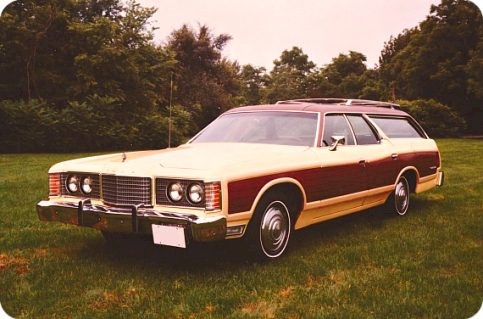Taylor Clark ought to know how Starbucks got its roc-like wingspan. That’s the tale by which we want to be spellbound. Clark quotes a 1997 Larry King interview with Howard Schultz, the company’s chairman, where Schultz outlines what should have been the plot of Clark’s book:
“People weren’t drinking coffee. … So the question is, How could a company create retail stores where coffee was not previously sold, … charge three times more for it than the local doughnut shop, put Italian names on it that no one can pronounce, and then have six million customers a week coming through the stores?”
Category: Culture
Pre Steroid Era Brewer Logo?

I saw a young man wearing a classic Brewers baseball cap earlier today. It occurred to me that this is the “pre steriod era” logo.
Requiem for a Station Wagon

One of the rare examples of altruism in pistonheads concerns the (nearly extinct) American station wagon. They passionately defend the one automotive genre that the vast majority of American consumers wouldn’t be caught dead in (excepting a hearse). Why so much love for a car shape that’s been fading from the American scene for the best part of 25 years? The passion comes from recognition. The reality we’ll have to blame on Darwin and his stupid birds.
Wagons increase a car’s cargo space without altering the donor car’s fundament shape. They’re a bit heavier and generally a little shakier than their sedan sibling, but still offer car-like driving dynamics. This is important to enthusiasts, who value driving dynamics sur tout. Ironically, pistonheads hate compromises; generally speaking, they don’t buy wagons. But they recommend them to others– especially SUV owners– based on the combination of handling and hauling.
If robotics technology now stands where computing did in the ’70s, what can we expect in the future?
Fremont resident Rakesh Guliani likes to say that a Roomba robotic vacuum cleaner saved his marriage.
Messy floors had been causing friction, says the 41-year-old Guliani (pronounced Goo-liani). His wife, Kavita, 35, was particularly annoyed by the footprints he and their daughters, Ashna, 10, and Rhea, 6, tended to track through the house.
“I am soccer coach to both of them, and when we come in with our dirty cleats, I am more tolerant of that because I am tracking dirt, too,” says Guliani, vice president of the job-placement firm Park Computer Systems. He vacuumed several times a week but it never seemed enough to satisfy his wife, a technical writer for Google.
“I was sucking the thread out of the carpet,” says Guliani, who bought a Roomba last fall and programmed it to scour the carpets for dust, dirt and grime. Regular cleanings by the Roomba restored household harmony. “It never gets bored and it never complains,” he says.
The Guliani family is at the cutting edge of what may be the next technological revolution – the emergence of software and hardware capable of performing tasks once reserved for that race of toolmakers called Homo sapiens.
“Sometime in the next 30, 40, 50 years we will have human-level machine intelligence,” predicts Marshall Brain, a computer science teacher turned author and technology forecaster.
Everyone’s Poop
“Down the drain, off the brain” is how most people think about it, but human waste—or effluent, as the professionals call it—has a lot to tell us about how we live, what we eat, and who we are.
They say that shit runs downhill. This is commonly understood to mean that the world is an unfair place, except among those few people who actually work with the substance, for whom it is considered something of an article of faith. This is because municipal sewerage systems are powered almost entirely by gravity, which means that when working properly, they move millions of gallons of sewage a day across considerable distances with only a minimum expenditure of energy, a feat of efficiency virtually unparalleled in the annals of engineering. When sewage stops running downhill, as it inevitably does from time to time, very bad things indeed can happen, as they did on Pecan Springs Road, in the Austin neighborhood known as Windsor Park, one morning last September.
I was spending the day with an Austin Water Utility emergency-response crew when dispatch got a call from a woman reporting that two rooms of her house were flooded with sewage. Our crew consisted of a TV truck, piloted by a twenty-year line-maintenance veteran named David Eller, and a flusher truck, driven by another longtime utility employee, named Dale Crocker. At the house, Eller, who wears wraparound sunglasses and looks a little like the country singer Dwight Yoakam, unspooled a thick red cable from the back of his truck. On the end of the cable was a camera about the size of a roll of quarters, which Crocker shoved down into a PVC clean-out pipe near the curb in the front yard. The woman leaned on a walker in her driveway, looking worried.
Excellent Article.
Great Web 2.0 Video
An Extraordinary VR Journey – The Latest VRMAG
Editorial Director Marco Trezzini, via email:
Since I believe we have created the best issue of VRMAG ever, I’m writing you with the hope you will accept to dedicate 5 minutes of your time to explore our online magazine dedicated to photographic virtual reality exploration of people, places and events around the world. Almost forgot to mention, VRMAG is a no profit publication, with no ads.
This issue features the closed zone of Chernobyl, Wired NextFest in Los Angeles, Cuba’s capital city La Habana, Red square in Moscow, the Palaces where European Royalties lives, New York’s Tribute in light, the island of Cyprus’s Aphrodite beach, Valentino’s exhibit Ara Pacis museum in Rome, the Mayan ruins Chinkultic and Tenam Puente in Mexico, Vienna, the Copenhagen Opera House, Seattle, RedBull AirRace Abu Dhabi ….
For VRMAG showing panoramas of the physical world is not enough,
so we’ll take you to Second Life in order to visit Anshe Chung’s Picture Gallery Dresden, and to DanCoyote’s Full Immersion Hyperformalism and get behind the scenes on the creation of next generation interactive screenshots for the gaming industry, take a visit to an “wellenkreis” an art installation of an endless sine curve in real space …
You will experience the view a sleeping pill has from it’s medicine bottle,
watch the world as a coca cola would do, transport you into a washing machine and feel like your sock. Be a fish and be intrigued by a guy ironing underwater,
enter the head of Hermann’s sculpture, chat with Jonathan livingston, experience a bubble party, feel the thrill of extreme canyoning, and much more …
Visit www.vrmag.org now.
Snowblower Zeitgeist, or the Best Urban Snowblower


I’ve manually moved snow for the past 14 years – my entire post UW time in Madison. Always thinking that the act was a bit of exercise until a neighbor mentioned his back difficulties and said “it’s not worth it”.
Last spring’s deluge, a particularly wet and heavy snowstorm, was the impetus to turn over the shovel, fire up my browser and shop for a snowblower.
My first stop was Ariens’ website. Ariens is a classic family owned Wisconsin based firm that manufactures snowblowers and lawn mowers.
Most serious snowblowers, defined as two stage models from the likes of Ariens, John Deere, Honda and Toro among many others are at least 24″ wide (Toro has a 22″ model). That width is a problem for small garages like mine.
Ariens offered a useful 20″ model that featured a multiple speed transmission – perfect for a variety of snow conditions and available at a reasonable price. Conveniently, their website offers online ordering which made it simple for me to enter a bit of information and a few days later the snowblower arrived at my home. Ariens customer service was great, as was their local dealer – Middleton Power Center.
About the snowblower zeitgeist. The owner of a working, somewhat powerful snowblower on a day like today (crunchy, heavy snow) quickly has the opportunity to converse with the neighbors. Typical conversations include:
- “Can I pay you to clear my driveway (no, if I have enough gas and time, I’ll be happy to)
- “My snowblower won’t start.”
- “I attempted to purchase a snowblower yesterday, but just before I said that I’ll take the last one, someone else grabbed it.”
- or, Chaplin moments when a neighbor is somberly pondering the large, heavy pile of snow recently deposited by the City plow in his driveway as I’m clearing another neighbor’s walks and driveway.
There you have it. Living in a cold climate subject to snow, we should never turn away from neighborhood social opportunities. Buy a (two-stage) snowblower.
I would be remiss if I did not point out the powerful prose at work marketing such machines. Arien’s description of their model 624E:
624E Compact
After 9 months of hibernation, this compact monster, has an appetite for the cold and crystallized.
When the white and fluffy flakes begin to fall; the corners of the 24” clearing width begin to salivate. The 120 volt electric start quickly awakens the 6HP Snow King® OHV Engine. You fear nothing! Snow fears this trusted Sno-Thro® midsized monster. Keep the snow afraid and out of your way.
A Glimpse of Pottersville
THE 1946 MOVIE IT’S A WONDERFUL LIFE has become a holiday favorite for many Americans. The heart-rending story of George Bailey (played by Jimmy Stewart), who in his hour of despair is vouchsafed a glimpse of what the world would be like if he’d never been born, holds great meaning for many Americans. So does the drama played out between George and his father, Peter, and their professional nemesis, rich old banker Henry Potter (Lionel Barrymore), which provides a vivid look at the dramatic changes that had taken place in American finance in the years leading up to the time the movie was made.
The recent problems in the mortgage market bring the story and its characters to life once again. The Baileys and Old Man Potter disagreed about a number of things, but principally about the credit-worthiness of what Potter calls “the riff-raff,” the average citizens in their home town of Bedford Falls. The Baileys believe they are credit-worthy, and Potter generally does not.
Potter remembers the recent past, when lenders made the rules, insisting on repayment in gold coin or its equivalent, on big down payments and short terms. Most important for middle-class folks, Potter sees residential real estate as illiquid, mediocre collateral. George and Peter Bailey and their Building & Loan envision a future of suburban development, of small down payments and decades to pay. When George looks at the world had he never been born — and sees a vacant field instead of the Bailey Park housing development financed by the Bailey Building & Loan — he is looking at what would have been Pottersville.
“The” way vs “a” way (Japan v China dept)
James Fallows offers up an interesting contrast between Japan and China.
